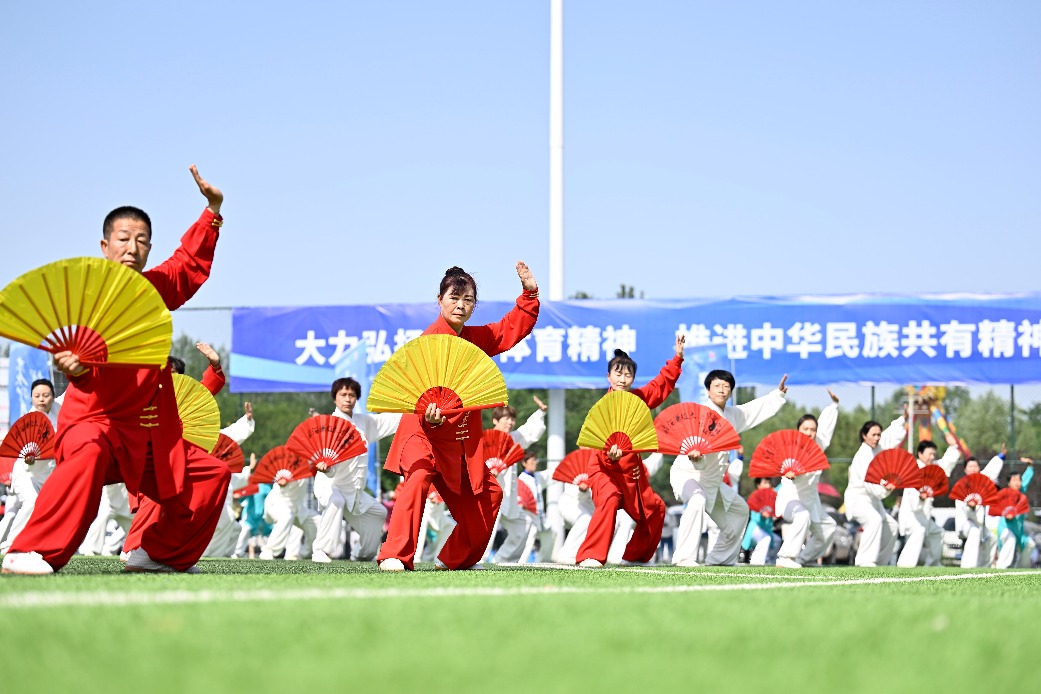China goes green in a big way

Eco-friendly building technologies in Europe can obtain sufficient scale for commercial success
China is increasingly becoming a large market and testing hotbed for new green building technologies important in the reduction of carbon dioxide emissions, experts say.
"Construction is a very large sector in China, and collectively the industry, in the decades to come, could deliver significant low-carbon innovations that will realistically result in China becoming a world leader in sustainability," says Steven Smit, design director of architecture at Atkins, a global design, engineering and project management consultancy.
| The Teda H2 building designed in Tianjin by Atkins. Twenty-eight percent of China's carbon emissions originate from energy use in buildings. Provided to China Daily |
| Suzhou Sports Park, a green building project, by Mott MacDonald. |

"Many building research institutes in China are trying to understand what works best in certain climate zones in China. People studying environmental building effects in China accept that the large-scale application of appropriate sustainable building solutions will lead to significant greening of the industry," says Smit.
Twenty-eight percent of China's carbon emissions originate from energy use in buildings, highlighting the crucial role of green building techniques, according to a 2013 research report by Global Buildings Performance Network and the Energy Foundation China.
Green building has also emerged as a buzzword in China since it was highlighted as a priority in the 12th Five-Year Plan (2011-15). Most of China's first-tier cities have set up new green building regulations in line with national policies.
This trend opens up opportunities for foreign firms with green building technology, including architects and city planners who can build in energy-efficient features coherent with surrounding infrastructure. It also includes new-energy and engineering firms with niche sector technology being implemented in buildings in China.
Smit says Atkins has contributed to many green building projects in China, such as the Teda H2 building, a government building in Tianjin that has four green building certificates: the US LEED (gold), the Chinese 3-Star (3 stars), the Japanese CASBEE (S class) and the British BREEAM (very good).
He says the H2 building has an energy-saving, comfortable indoor environment thanks to its architectural and engineering design. The building has layered facade structures and high-performance materials for sustainability. Photovoltaic panels are used, double-glazed glass improves insulation, and a gray water system reduces potable water consumption. Gray water is wastewater from washing that can be treated and reused for some purposes.
Atkins uses Building Information Modeling software, a 3-D format that allows design analysis before construction to keep costs down.
Smart technologies are being developed to monitor lighting, energy levels and other functions, Smit says. Leading Chinese developers such as Vanke and Chinese universities are devoting many resources to green technology.
He says the large scale of construction in China could take advantage of modular construction, likely to be used for Chinese green building technology in the future. Modular construction makes use of factory-produced, low-carbon building components that can be precisely assembled on site with potentially huge energy consumption and cost savings.
Although green buildings are emerging rapidly in China, they are still just a fraction of new construction in comparison with mature economies, says Pang Qin, director and head of the architecture firm Benoy's Shanghai Studio.

Only 17 percent of new buildings in China's first and second-tier cities meet green building standards, as specified by LEED, BREEAM and China 3-Star. Most of that is in China's first-tier cities, highlighting the need for change in the rest of the country.
Pang says Benoy's green building projects have showcased the potential of sustainable design to not only benefit the wider environment, but also to improve everyday life.
"At the conception of a project, not unlike a surgeon carefully connecting a new organ to an existing body, we as architects have to integrate our designs into the fabric of each unique ecosystem. We must consider how we can create positive change, or indeed strengthen existing assets in the wider community," Pang says.
He says creating a cohesive environment in which the development achieves harmony with its surrounding connections is vital.
"For example, by focusing on creating adequate connectivity, these developments can provide the opportunity for individual change. The community is given convenient access to a larger mix of facilities and the potential to access public transport. People coming to the building will drive less, and the resulting consumption of energy will be less," Pang says.
Developing design for future flexibility is important, for example, in maximizing connections between buildings to create a more user-centric and convenient experience, he says. "An interesting case in point is connecting underground car parks between two buildings, allowing cars the flexibility to park in the spaces of an adjacent plot once the existing one is full, creating efficient utilization of resources," Pang says.
Chris Hardie, director of the Shanghai office of the Danish company Schmidt Hammer Lassen Architects, says environmentally friendly techniques also involve maximizing the use of existing materials, and his firm has been involved in many projects using this concept. One example is the Green Valley project at the former 2010 Shanghai World Expo site. Hardie's staff helped turn the site into a commercial district with cultural attractions.
"Our idea is that we would create a space for people to use as corporate headquarters, but also contains parks and well-connected public transport. There will be natural ventilation, creating a good holistic environment," Hardie says.
The Green Valley project includes offices, shops and restaurants. A central open space with water and landscaping runs through the middle of the site. Hardie says this arrangement will allow the area to be used during the day and at night, unlike pure commercial districts that are "dead after office hours".
The firm also designed the 10-hectare campus of the Labor Union's new cultural center in Ningbo, China. The firm won the bid in a competition last year. Located next to an ecological wetland area, the "Home of Staff" cultural center will offer a mix of residential, health, education, culture, and leisure facilities for almost 3 million users.
The firm proposed to maximize green space by turning the roof over the buildings into a planted area. "They can use this green space on the roof for people's leisure activities, and for the collection of rainwater. We wanted it to be a visual amenity, so it is not just one additional element for the building, but can be used as lots of assets," Hardie says.
Different sectors of Chinese society are boosting the green trend. "The Chinese government has paid greater attention to green and low-carbon building design and construction recently, while developers have also realized the importance of sustainability as well," says Aaron Zhou, green building team leader for engineering consultancy Mott MacDonald in China. Zhou says green building techniques are now expected on all government-backed projects and buildings of more than 20,000 square meters, while in the near future it will be a requirement that all new buildings achieve at least a one-star certification from the Chinese Green Building system.
He says China's design institutes are also getting better, so designs and technologies in China will quickly catch up.
One example of a green building project Mott MacDonald has worked on is the Suzhou Sports Park. It utilizes a system in which outdoor air is pre-cooled in summer and pre-heated in winter through underground plastic pipes before being fed into an indoor air-handling unit.
This system is more efficient than standard air-conditioning systems, in which air is cooled or heated directly by the air-handling unit, because the soil's temperature is stable year-round lower than outdoors air in summer, higher than outdoors air in winter, Zhou says.
Ben Pape, founding partner of London-based consultants Pall Mall Principals, says China's scale also is good for development of new technology. "China provides great potential to develop and commercialize environmentally friendly technology, as the market for construction is very big, meaning new technology would become economically viable by benefiting from scale," Pape says.
Pall Mall is in the process of commercializing a new technology to turn straw into straw board for use as a construction material. The board would be as strong as wood but would require much less energy to produce, and also makes good use of abundant waste straw.
"Every year, China burns a lot of straw, which is a major source of pollution. This problem can be solved by making it into environmentally friendly straw board. Straw boards are also more cost efficient, saving costs for construction projects," Pape says.
Although the straw board technology was developed in the UK, it has never achieved viable scale, and Pape hopes that the success of this technology in China will allow it to be exported to benefit the construction industry globally.
Pape is also a founding member of the UK-China Eco-Cities and Green Building Group. He says the UK is a leader in green building ideas and concepts due to its high level of creativity and innovation, but China is a good place to commercialize these ideas. In 2012, a report by the group gave China suggestions on sustainable development.
"The UK has many smart ideas but the lack of scale and stringent regulations means the commercialization of many ideas are harder to achieve. Therefore, China provides a great opportunity for these ideas to be implemented and the result will be very good green building technology globally," he says.
cecily.liu@chinadaily.com.cn
(China Daily Africa Weekly 07/03/2015 page14)
Today's Top News
- Xi urges all-out rescue efforts following mountain torrents in Gansu
- A Quixotic quest to reindustrialize US
- Grassroots sports events promoting nation's fitness goals
- Major test brings lunar mission closer to reality
- China likely to continue buying gold
- World Games dazzle spectators in Chengdu
































